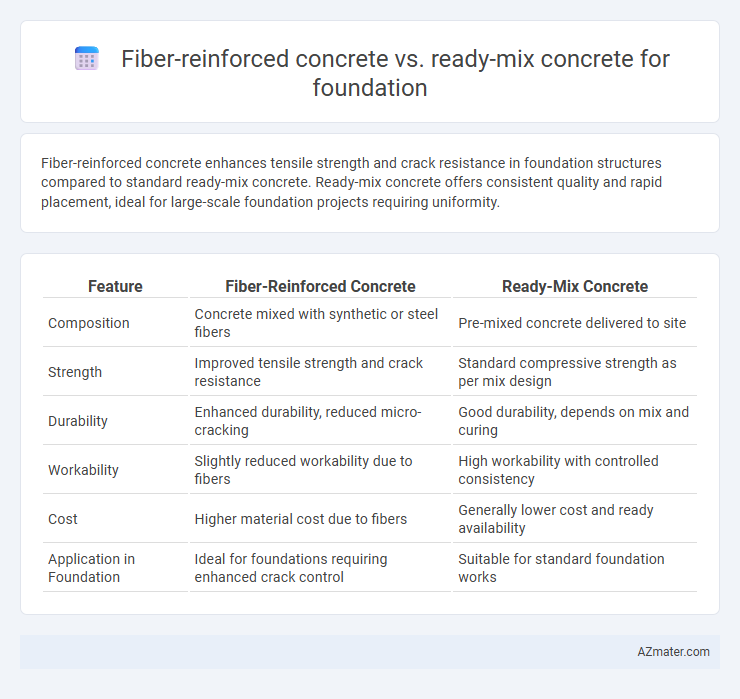Fiber-reinforced concrete enhances tensile strength and crack resistance in foundation structures compared to standard ready-mix concrete. Ready-mix concrete offers consistent quality and rapid placement, ideal for large-scale foundation projects requiring uniformity.
Table of Comparison
| Feature | Fiber-Reinforced Concrete | Ready-Mix Concrete |
|---|---|---|
| Composition | Concrete mixed with synthetic or steel fibers | Pre-mixed concrete delivered to site |
| Strength | Improved tensile strength and crack resistance | Standard compressive strength as per mix design |
| Durability | Enhanced durability, reduced micro-cracking | Good durability, depends on mix and curing |
| Workability | Slightly reduced workability due to fibers | High workability with controlled consistency |
| Cost | Higher material cost due to fibers | Generally lower cost and ready availability |
| Application in Foundation | Ideal for foundations requiring enhanced crack control | Suitable for standard foundation works |
Introduction to Foundation Concrete Types
Fiber-reinforced concrete enhances foundation durability by integrating synthetic or steel fibers, improving tensile strength and crack resistance compared to traditional ready-mix concrete. Ready-mix concrete offers consistent quality and ease of application, making it a widely used choice for various foundation types. Choosing between fiber-reinforced and ready-mix concrete depends on load requirements, environmental conditions, and budget constraints.
What is Fiber-Reinforced Concrete?
Fiber-reinforced concrete (FRC) is a composite material incorporating discrete fibers such as steel, glass, or synthetic polymers to enhance tensile strength, durability, and crack resistance in foundation applications. Unlike standard ready-mix concrete, which relies solely on coarse and fine aggregates, FRC improves load distribution and structural integrity by controlling shrinkage and temperature-induced cracking. This makes fiber-reinforced concrete particularly advantageous in foundations subject to heavy loads and dynamic stresses.
Understanding Ready-Mix Concrete
Ready-mix concrete is a pre-mixed blend of cement, aggregates, water, and admixtures prepared in a batching plant, ensuring controlled quality and consistency ideal for foundation work. It offers ease of placement and uniformity, reducing onsite labor and minimizing the risk of errors compared to mixing concrete manually. While fiber-reinforced concrete enhances tensile strength and crack resistance, ready-mix concrete remains a versatile and reliable solution widely used for foundation construction due to its timely delivery and precise mix proportions.
Strength and Durability Comparison
Fiber-reinforced concrete (FRC) exhibits superior tensile strength and crack resistance compared to traditional ready-mix concrete, making it ideal for foundation applications requiring enhanced durability. FRC incorporates synthetic or steel fibers that improve impact resistance and reduce shrinkage, which significantly extends the lifespan of foundations under dynamic loads. Ready-mix concrete, while consistent and convenient, typically lacks these fibers, resulting in lower tensile strength and greater susceptibility to cracking over time in demanding structural conditions.
Crack Resistance and Flexural Performance
Fiber-reinforced concrete significantly improves crack resistance and flexural performance in foundation applications by integrating synthetic or steel fibers that control crack propagation and enhance tensile strength. Ready-mix concrete offers convenience and consistent quality but generally lacks the inherent crack control and toughness provided by fiber reinforcement. The incorporation of fibers reduces shrinkage cracks and increases ductility, making fiber-reinforced concrete more suitable for foundations exposed to dynamic loads and potential ground movement.
Installation Processes and Practicality
Fiber-reinforced concrete simplifies installation by eliminating the need for traditional steel rebar placement, reducing labor time and risk of errors in foundation construction. Ready-mix concrete offers consistency and is delivered directly to the site, speeding up the pouring process but requires on-site reinforcement setup, which can increase complexity and time. Practicality favors fiber-reinforced concrete in projects with tight schedules or limited skilled labor, whereas ready-mix concrete suits larger foundations where standard reinforcement and quality control are critical.
Cost Differences and Budget Considerations
Fiber-reinforced concrete typically incurs higher initial costs than ready-mix concrete due to the added expense of synthetic or steel fibers, which enhance durability and crack resistance in foundations. Ready-mix concrete offers a more cost-effective solution for large-scale projects with tighter budgets, providing consistent quality and faster pouring with minimal labor expenses. Budget considerations should weigh the long-term benefits of fiber-reinforced concrete's increased lifespan and reduced maintenance against the upfront savings of ready-mix concrete.
Sustainability and Environmental Impact
Fiber-reinforced concrete enhances structural durability and reduces micro-cracking, leading to extended lifespan and less frequent repairs, which supports sustainable construction practices. It often requires less cement content than traditional ready-mix concrete, lowering carbon emissions associated with cement production. Ready-mix concrete's centralized batching reduces material waste but generally results in higher CO2 emissions due to greater cement usage, impacting its environmental footprint negatively compared to fiber-reinforced alternatives.
Suitability for Different Foundation Types
Fiber-reinforced concrete enhances tensile strength and crack resistance, making it highly suitable for slab-on-grade foundations and thin-shell structures requiring durability against shrinkage and impact. Ready-mix concrete offers consistency and versatility, ideal for deep foundations such as piles and caissons where precise mix design supports load-bearing capacity. Choosing between the two depends on structural demands, with fiber-reinforced concrete preferred for foundations subjected to dynamic stresses and ready-mix concrete favored for standardized, heavy-load applications.
Choosing the Right Concrete for Your Foundation
Fiber-reinforced concrete enhances the structural integrity of foundations by improving tensile strength and crack resistance, making it ideal for high-stress environments. Ready-mix concrete offers consistent quality, faster placement, and reduced labor costs, suitable for standard foundation projects with predictable load requirements. Selecting the right concrete depends on factors such as load-bearing capacity, environmental conditions, and long-term durability needs of the foundation.

Infographic: Fiber-reinforced concrete vs Ready-mix concrete for Foundation
 azmater.com
azmater.com